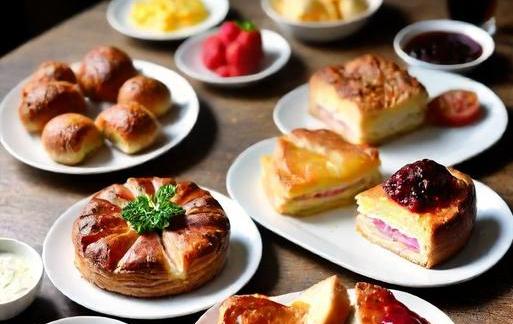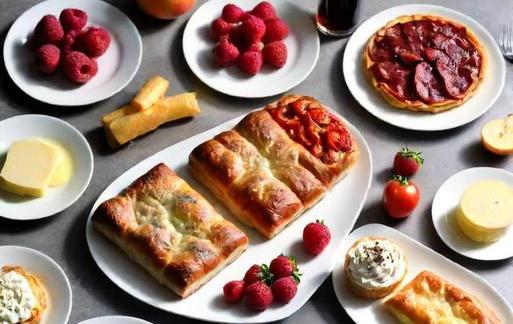- You are here:
- Home »
- Food
- » [REVEALED] French Foods That Start With M
[REVEALED] French Foods That Start With M
Note: This page contains affiliate links.
As an Amazon Associate, I earn from qualifying purchases when you click on the link, but you are not charged extra.
France, renowned for its rich culinary heritage, is a treasure trove of delectable dishes that captivate the taste buds and reflect the country’s dedication to gastronomy. In this gastronomic exploration, we delve into a specific letter of the French culinary alphabet – the letter M. Prepare to embark on a journey through the diverse and flavorful world of French foods that commence with the letter M. From iconic classics to hidden gems, each dish encapsulates the essence of French cuisine.
Contents
List Of French Foods That Start With M

1. Magret De Canard
Description: Magret de Canard, translated as duck breast, is a culinary masterpiece that showcases the French expertise in preparing duck. The dish involves pan-searing the duck breast to achieve a crispy skin while maintaining a succulent and flavorful interior. Often served with a luscious red wine reduction sauce, Magret de Canard embodies the rich flavors synonymous with French cuisine.
Recommended Pairing: A robust Bordeaux wine, such as a Pomerol or Saint-Émilion, complements the bold flavors of Magret de Canard.
2. Moules Marinières
Description: Moules Marinières, or mariner-style mussels, is a quintessential French seafood dish. The mussels are steamed in a flavorful broth composed of white wine, shallots, garlic, and parsley. This classic maritime delight encapsulates the freshness of the sea, harmonizing with the aromatic blend of herbs and wine.
Recommended Pairing: A crisp Sauvignon Blanc or a light-bodied Chablis accentuates the briny flavors of Moules Marinières.
3. Matelote
Description: Matelote is a traditional French fisherman’s stew, embodying the heartiness of French comfort food. This robust dish features freshwater fish, such as perch or pike, simmered in a rich red wine sauce with mushrooms, onions, and bacon. The amalgamation of earthy flavors creates a dish that is both rustic and refined.
Recommended Pairing: A medium-bodied Burgundy wine, like a Pinot Noir, complements the complex flavors of Matelote.
4. Madeleines
Description: Transitioning to the sweeter side of French cuisine, Madeleines are delicate, shell-shaped sponge cakes that have become a symbol of French patisserie. These small, buttery cakes are infused with flavors such as lemon zest or vanilla, providing a delightful accompaniment to afternoon tea or coffee.
Recommended Pairing: A light and floral tea, such as Earl Grey, enhances the subtle sweetness of Madeleines.
5. Magnum
Description: Magnum, often referred to as "Magnum Glacé," is not a traditional French dish but deserves a mention as a popular French ice cream treat. Consisting of a thick layer of chocolate coating enrobing a variety of ice cream flavors, Magnum exemplifies the French passion for elevating even the simplest pleasures into a luxurious experience.
Recommended Pairing: While traditionally enjoyed on its own, a drizzle of warm caramel or a sprinkle of fleur de sel can enhance the indulgence of a Magnum.
6. Mille-Feuille
Description: Mille-Feuille, translating to a thousand layers, is a classic French pastry known for its intricate and delicate construction. Layers of puff pastry alternate with velvety pastry cream, creating a textural marvel. Topped with a glossy layer of fondant or powdered sugar, Mille-Feuille is a testament to French pastry craftsmanship.
Recommended Pairing: A light and effervescent Champagne or a sparkling wine complements the layers of Mille-Feuille without overpowering its delicate flavors.
7. Magret Confit
Description: Magret Confit is a sumptuous dish that involves slow-cooking duck leg in its own rendered fat until tender and flavorful. This method of preparation results in meat that is both succulent and falling-off-the-bone, with a crispy skin. Magret Confit pays homage to the French tradition of preserving meats, offering a taste of culinary history.
Recommended Pairing: A robust red wine, such as a Malbec or Cahors, complements the richness of Magret Confit.
8. Morbier
Description: Morbier, a semi-soft cow’s milk cheese, hails from the Franche-Comté region of France. Recognized by its distinctive layer of ash running through the center, Morbier boasts a creamy texture and a mild, nutty flavor. Pair it with crusty bread or fresh fruit for a delightful cheese experience.
Recommended Pairing: A light and fruity red wine, such as a Beaujolais, enhances the nutty notes of Morbier.
9. Moussaka
Description: While Moussaka has its roots in Mediterranean cuisine, the French have embraced this layered casserole as their own. This hearty dish features eggplant, minced meat, and a luscious béchamel sauce. Baked to perfection, Moussaka embodies the amalgamation of flavors that characterize the diversity of French gastronomy.
Recommended Pairing: A full-bodied Rhône red wine, like a Côtes du Rhône, complements the robust flavors of Moussaka.
10. Macarons
Description: No exploration of French foods starting with M would be complete without mentioning Macarons. These delicate and colorful almond meringue cookies sandwiched with a creamy filling have become synonymous with French patisserie. With a wide array of flavors, from classic pistachio to exotic lychee, Macarons showcase the artistry and precision of French pastry chefs.
Recommended Pairing: A light and fruity Champagne or a floral Gewürztraminer complements the sweetness of Macarons.
French cuisine, with its unparalleled dedication to flavor and culinary craftsmanship, continues to enthrall gastronomes worldwide. In this exploration of French foods that start with M, we've traversed the realms of savory and sweet, traditional and modern. From the succulent Magret de Canard to the delicate layers of Mille-Feuille, each dish tells a story of France's culinary prowess. As you savor these French delights, remember that the true essence of French cuisine lies not just in the ingredients but in the artistry and passion with which they are prepared. Whether you're indulging in the comforting warmth of Matelote or experiencing the exquisite precision of Macarons, each bite is a celebration of France's gastronomic heritage. So, immerse yourself in the world of French foods that start with M, and let your taste buds embark on a journey through the heart of French culinary excellence.
Significance

France, renowned for its rich culinary heritage, has bestowed upon the world a diverse array of delectable dishes. In this gastronomic journey, we focus on a specific letter of the alphabet, unveiling a collection of French foods that start with the letter "M." From mouth-watering pastries to savory delights, each dish encapsulates the essence of French cuisine. Join us as we embark on a flavorful exploration of these "M"-starting French delicacies.
The significance of French cuisine extends beyond its flavors; it embodies cultural, historical, and social elements that have shaped the nation’s identity. The meticulous preparation and presentation of French dishes reflect a deep appreciation for culinary artistry. By delving into the world of French foods that start with "M," we gain insights into the traditions, regional variations, and the mastery that defines French gastronomy.
Category-Related

1. Main Courses
1.1. Ratatouille
Originating from the Provence region, Ratatouille is a vegetable medley featuring eggplant, zucchini, bell peppers, tomatoes, and seasoned with aromatic herbs. This hearty dish showcases the French affinity for fresh, locally sourced produce.
1.2. Moules Marinières
Moules Marinières, a coastal delicacy, consists of plump mussels steamed in white wine, shallots, garlic, and herbs. Served with crusty bread, it offers a taste of the sea with a touch of elegance.
1.3. Magret De Canard
Magret de Canard, or duck breast, is a succulent dish often prepared with a sweet and savory orange glaze. This exemplifies the French mastery of balancing flavors, creating a harmonious symphony on the palate.
2. Pastries And Desserts
2.1. Madeleines
The petite shell-shaped Madeleines are buttery sponge cakes with a hint of lemon zest. These delicate treats, often enjoyed with tea or coffee, are emblematic of French baking finesse.
2.2. Mille-feuille
A pastry lover’s dream, Mille-feuille, also known as Napoleon, is a layered confection of puff pastry, pastry cream, and icing. Its precise construction mirrors the meticulous nature of French pastry craftsmanship.
2.3. Mont Blanc
Mont Blanc, named after the iconic mountain, is a dessert featuring chestnut purée, whipped cream, and meringue. This sweet indulgence reflects the French penchant for transforming humble ingredients into gourmet delights.
3. Cheeses
3.1. Munster
Hailing from the Alsace region, Munster is a pungent and creamy cheese with a distinctive orange rind. Its bold flavor profile is a testament to the diversity within the realm of French cheeses.
3.2. Maroilles
Maroilles, originating from Northern France, is a washed-rind cow’s milk cheese known for its robust aroma and tangy taste. The cheese-making traditions associated with Maroilles have been preserved for centuries.
4. Beverages
4.1. Mocha
While not exclusive to France, the Mocha, a coffee blend with chocolate and milk, finds its place in French cafes. The French appreciation for coffee extends beyond its preparation, encapsulating the cultural significance of leisurely coffee breaks.
4.2. Mâcon
Mâcon, a white wine from the Burgundy region, is celebrated for its crispness and floral notes. The diversity in French wines is a testament to the country’s varied terroirs and winemaking expertise.
Common Themes
Regional Diversity
French cuisine is a tapestry woven with regional nuances, each area contributing its unique flavors and culinary techniques. From the Mediterranean-influenced Ratatouille in the South to the heartiness of Magret de Canard in the Southwest, the "M" foods showcase the geographical diversity that defines French gastronomy.
Fresh And Local Ingredients
The emphasis on fresh, seasonal, and locally sourced ingredients is a common thread in French cooking. Whether it’s the vibrant vegetables in Ratatouille or the earthy chestnut purée in Mont Blanc, French chefs prioritize quality ingredients to elevate the flavors of their dishes.
Balanced Flavors
French cuisine is celebrated for its ability to strike a harmonious balance of flavors. From the sweet and savory notes in Magret de Canard to the contrast of textures in Mille-feuille, the "M" foods exemplify the French commitment to achieving a perfect culinary equilibrium.
Interesting Facts
1. Madeleine’s Literary Connection
The Madeleine holds a special place in literature, famously mentioned in Marcel Proust’s work "In Search of Lost Time." The author’s evocative description of dunking a Madeleine in tea has become a symbol of involuntary memory and sensory nostalgia.
2. Munster’s Monastic Origins
The production of Munster cheese has historical ties to monastic traditions. Monks in the Vosges Mountains are believed to have introduced the unique cheese-making techniques that contribute to Munster’s distinct flavor and texture.
3. Mille-feuille’s Royal Heritage
Mille-feuille’s origins trace back to the 17th century, where it was created by French pastry chefs to commemorate the marriage of Marie Antoinette and Louis XVI. This decadent pastry has since become a symbol of elegance and sophistication.
Conclusion
In the world of French cuisine, the letter "M" unfolds a culinary panorama that ranges from rustic main courses to exquisite pastries and cheeses. Each dish tells a story of tradition, innovation, and the French commitment to culinary excellence. From the sun-soaked fields of Provence to the misty mountains of Alsace, the "M" foods provide a taste of France’s diverse landscapes and culinary prowess. As we savor the flavors of Ratatouille, indulge in the layers of Mille-feuille, and appreciate the complexities of Munster, we partake in a gastronomic journey that transcends mere sustenance, offering a glimpse into the soul of French culinary artistry.


